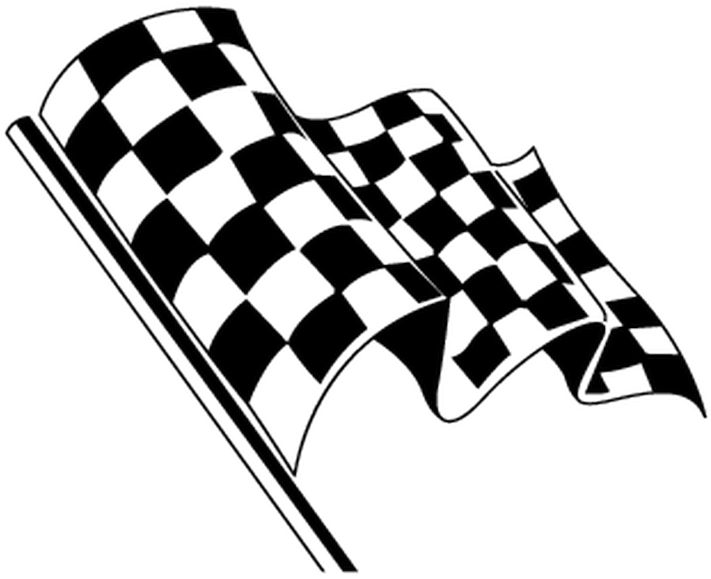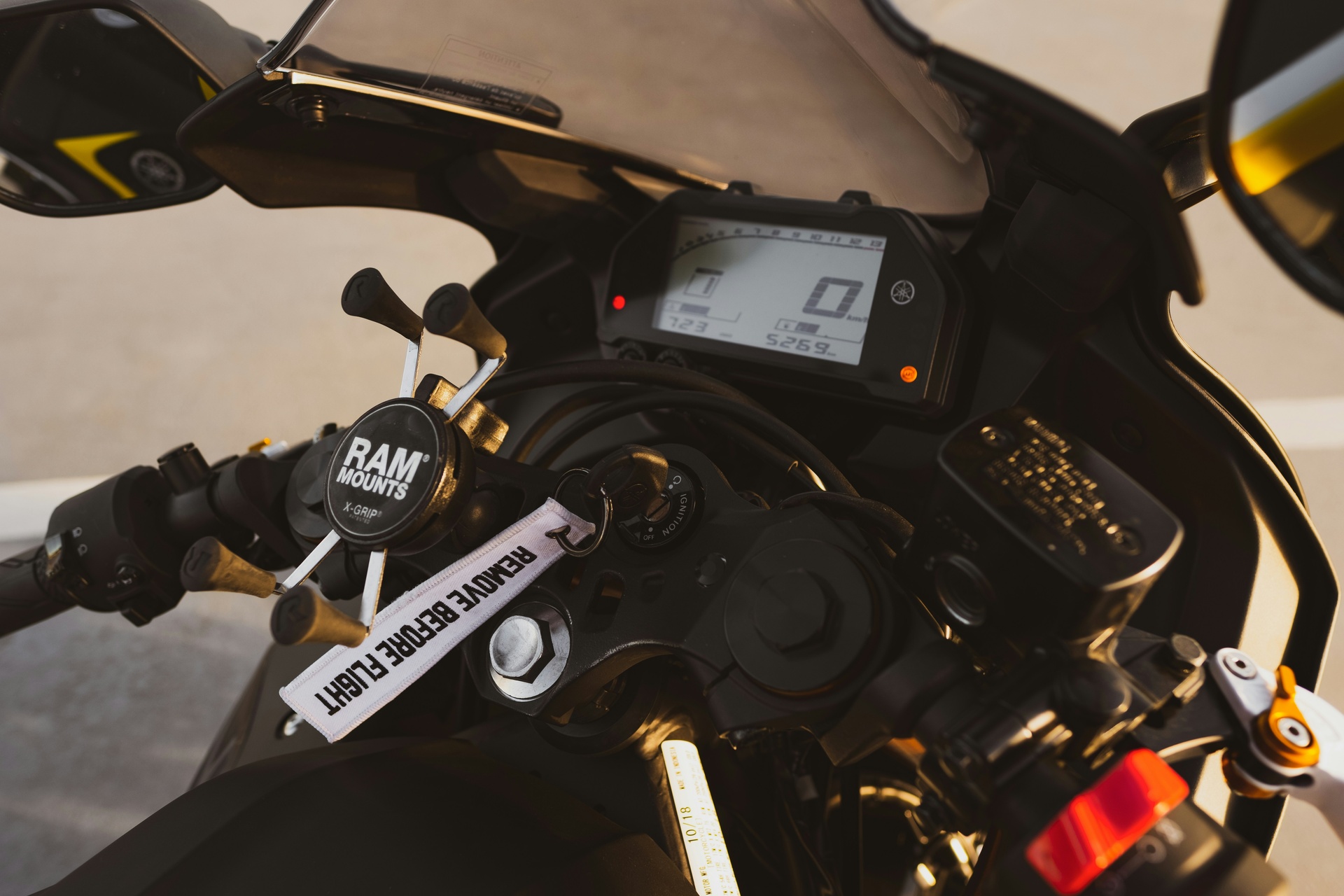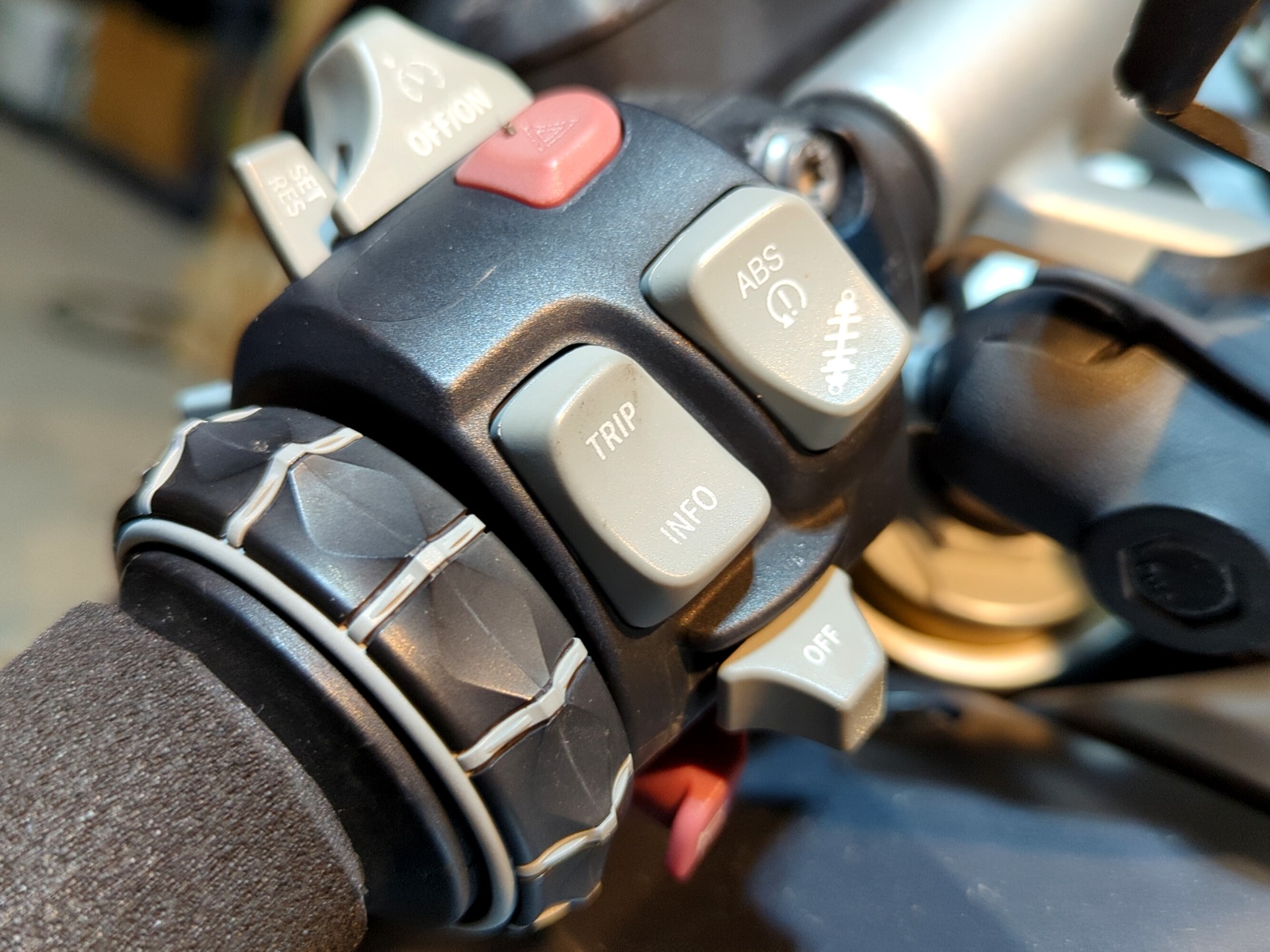Savor our FTC disclosure's epic tale here. The following article was last updated on Dec 5, 2025 ...
Borrowed Bike: Riding OPM (Other People's Motorcycles)
Two-wheeled vehicles are kinda freaky. Compared to (ugh) enclosed vehicles, there's a much wider range of ergonomics and they require far more physical, whole-body, whole-brain skills to operate.
Things like center of gravity and handling characteristics are all over the place. Plus, you usually have two separate braking systems to learn and manage and even simple stuff like turn signals might be different than what you're used to.
What's the best approach when someone tosses you the key to their motorcycle? After all, it's something of a high honor and in most social circles it's considered quite gauche to stall, drop or wad up a bike that doesn't belong to you. We may be sweaty and covered in bug guts but there's still a certain high etiquette to it all.
That borrowed bike begs respect which means returning it in the same condition as received.
Why Ride A Borrowed Bike?
Alongside rider training, riding lots of different kinds of motorcycles is an important part of developing advanced riding skills. The skills to rapidly and safely suss out a new-to-you bike are well worth developing.
For one, it opens up a world of rental and travel possibilities. A fly-and-ride using Twisted Road or another motorcycle rental platform is a great way to skip the dreaded expanse of Kansas and save precious vacation days.
Riding lots of different bikes also gives you a deeper understanding of how these crazy contraptions work and even the psychology of the riders. You'll learn firsthand how differences in frame geometry, ergonomics, engine design, etc. combine to create different kinds of experiences that tickle the brain and body in different ways.
Bottom line, a borrowed bike can give you a new perspective and help you understand the nuances of different models.
On a related note, this also helps you sense and understand different problems more quickly and the effects of modifications and repairs. For example, is that vibration just something inherent to the bike, an out of balance tire or because the new luggage is overloaded or flapping around? Is that noise a normal clutch rattle or a camshaft death rattle? Is that wonky steering as simple as notchy steering stem bearings or bent forks? Is your buddy's bike you just pulled out of a ditch safe to ride home?
“A borrowed bike can sharpen both skills and manners, from quick checks to smooth braking so owners smile and the ride stays drama free.”
And finally, motorcycles are just, you know, a lot of fun. It's fun and interesting to sample all sorts of rides and riding styles. Even if, say, feet-forward cruisers aren't your thing, you'll learn something about the low and slow riding style and the riders who enjoy it. Maybe you'll even discover a whole new corner of your riding obsession to explore, like elemental vintage bikes, the challenges of dual-sport riding, the silky allure of triples or the simple giggly joys of scootering.
The same can be said for any borrowed bike. It's a fun and interesting way to try out different types of bikes and riding styles.
Ponder Your Purpose
As the key is in the air, hurtling toward your open palm, think about why you're doing this. Are you renting a bike you'll need to live with for the next week? Are you sampling a buddy's bike just for funsies? Are you trying to help diagnose a problem or confirm a fix?
And think about how you're going to ride this bike and for how long. If you're borrowing or swapping bikes with a buddy, make sure you're on the same page as to the length of the ride and the general velocity philosophy. Does she encourage and expect you to explore the outer uncharted reaches of the tread and tach or is a more measured approach polite? Is this a quick ten miles or half a day or more?
In a similar vein, if you're in a situation where you'll be trading bikes for a time, make sure you're both on the same page. I've politely declined or deferred test rides of interesting bikes because I wasn't 100% comfortable entrusting my bike to a particular person.
With that borrowed bike, it's important to have a clear understanding with the owner about how long you'll have it and how you'll use it.
First, A Bit O' Borrowed Bike Safety
OK, you've got the keys and clearance from the tower. Hop on and rock on, right? Not so fast. Take a moment to walk around the bike and look it over for the basics of safety. Are the tires round and black and reasonably full of air? Is the chain (or anything else) unduly flappy or crunchy, does anything look "off"?
Don't worry about seeming rude. There's a concept called "normalization of deviance", where even experienced people can begin to overlook small safety-related items until things snowball into a real problem. It's surprising what people can learn to overlook on their own bikes and it's your skin and bones on the line.
Obviously, you can fast-forward this part a little for a trusted buddy's bike that you've been riding with for a few hours already. Trust, a little ... but verify anyway.
Despite all the words on this page, none of this takes very long. You won't harsh the moto-vibe by taking a few extra moments to ensure a positive experience all around. Always safety check a borrowed bike before you hit the road.
Take A Moment For A Pre-Start Soak & Poke
All good? Time to hop on, then take a little more time before you light the fuse to soak in the general vibe, figure out where everything is, grok the ergos and generally poke around until your brain understands what's where and how the daggum turn signals work.
For example, it always takes me some extra time when test-riding a cruiser to remember where to put my feet. I always have a few "feet scrabbling in the air" moments until I remember the pegs or floorboards are waaaaay out yonder.
Think about whether you're basically compatible with the bike. I've had to regretfully decline rides on super-dedicated sporty bikes when my ancient, damaged knees were simply not able to bend enough to squeeze onto the pegs and operate the controls.
Rock the bike left and right just a bit to get an idea of the center of gravity, top-heaviness and weight. Move the handlebars left and right all the way to understand the available steering lock and handlebar reach.
Squeeze the brakes and clutch and twist the throttle a little to assess free play. Control play can have a surprising effect on smoothly controlling the bike and it's one of those deviations that tends to creep up on owners. Bounce up and down a little to give your glutes a general idea of the suspension's compliance and damping. Adjust the windscreen, if available and needed.
Speaking of suspension, think for a moment about whether the owner is significantly larger or smaller than you and how the suspension setup might relate. Adjust expectations if you can't adjust preload. If you're vertically challenged and it's a taller bike, make sure you have the one-toe skills to manage safely. And make sure you're ready if the bike is heavier and/or more top-heavy than one you've ridden before.
If there are any computer controlled features you'll need to manage, ask the owner to explain these. For example, it can be fun to play with electronic suspension but sort out these controls before you start moving.
Ask the owner if there's anything in particular you need to know that's nonstandard. "Oh yeah, it's race pattern shifting" is kinda crucial information. If the clutch and/or side stand switches are disabled, you'll need to know. Same for things like warning lights, non-functional gas gauges or petcocks you need to turn off and on.
Oh and here's a pro tip from experience: figure out where the side stand is before you start moving. When it's time to toss the key back, you'll look kinda lame if you're frantically hunting around for the side stand tab.
Basically, familiarize yourself with borrowed bike features and quirks before you start riding.
C'mon Baby, Light My Fire
OK, time to fire it up and take a few seconds to get used to the engine vibration and sound, etc. Anything flapping around? Take note of where the instruments are and what they're telling you. Most are in peripheral vision but some require actually taking your eyes off the road. Many info-packed digital displays can be fairly confusing at first.
Make sure you know what any warning lights might be telling you. For example, ABS lights normally go on when you start the engine but turn off shortly after you start moving.
Pop it into first and think back to your MSF course for a moment. Find the clutch friction zone before you set sail. Stalling someone else's bike right in front of them is just plain embarrassing, ya know? Give it a little throttle and slowly let the clutch out, just a little and pull it back in a few times until you know where it starts to grab and how quickly.
Here's another pro tip: make sure there's gas in the tank. More than once I've hopped on to find a glowing gas pump or a needle buried to the left of "E", so I had to stop at the corner for a quick splash. Some people are just ... like that.
Just glance at that borrowed bike gas level before you start your ride. You don't want to be stranded with an empty tank.
Setting Sail
The first moments under way are pretty important. For the most part, motorcycles are motorcycles. Single-track vehicles have a lot of fundamental dynamics that are the same no matter what but there's a lot of variation as well. Your entire body is going to be disoriented at first. Keep it mellow until your cerebellum starts to understand what the heck is happening here.
If you're a relatively new rider or you've only ridden one bike for a long time, this can be incredibly disorienting, even a little panic-inducing the first few times.
Keep your inputs smooth and confident and keep your distance. Minimize low-speed maneuvering. Keep your speed above walking pace so that the bike is controllable. It's tempting to paddle-walk at stops and slow speed but it's also not very safe or effective.
Another important difference is in braking systems. There's a huge range here, from the often anemic drum or single-disc brakes on vintage bikes, dual-sports and cruisers all the way to the radial-piston one-finger-stoppie monsters on modern sportbikes. Not to mention the differences in rear brakes and the differences in technique required to balance front and rear braking action.
The best advice here is to keep your distance and work up slowly. Leave extra room for the first several stop signs. Be smooth and very progressive in your brake applications and experiment as possible. Again, experience helps your right hand and foot understand what to expect more quickly.
Lastly, make sure you understand whether the bike has ABS and how to use it. The basic technique for panic braking with ABS is simple. Keep squeezing and stomping until the situation resolves, even through the weird feel and noises.
And take it "this is a borrowed bike" slow until you get used to how it handles.
Performance Anxiety On A Borrowed Bike
Once you're more comfortable with the bike, time to grip it and rip it, right? There are a couple of things to remember here.
One, build up speed and lean angle slowly and deliberately. Don't just wobble through a few stoplights, then dive into the twisties at the edge of town at full patented Rossi Race Pace™. Learn the bike's handling, engine and brakes a few percent at a time, not all at once and stay well below the limits. Even if it's a bike more or less identical to yours, there can be surprises, like highway pegs or center stands that touch down early or squishy suspension.
Two, spare a thought for the owner's anxieties and expectations. No one likes to hear their bike screaming at redline or see the feelers throwing sparks two minutes after handing it over. Err on the side of "polite" and you'll increase your chances of future invitations.
Then again, once in a while the owner does want you to experience more of what the bike has to offer. But even if they tell you "give 'er hell!" with an unconcerned wave ... proper etiquette is still to leave more than a few percent in the bag.
Remember to respect the borrowed bike owner's wishes and treat their bike with care.
Post-Repair & Problem Rides
What if the bike ... just ain't right? Some of the most dangerous OPM rides you'll take aren't on remote twisty roads with macho names. They're those quick spins around the neighborhood after repairs on a buddy's bike. Not to mention the "Hey, I think something's wrong with my bike - can you ride it and let me know what you think?" rides.
Of course, the first line of defense is to review your work. Before you hop on, step back, re-think and make sure the job is really finished. Caliper and fork bolts tight? Axles tight? Brake function verified? Spills cleaned up? Zip-ties neatly trimmed? Fire extinguisher on hand? Mom on speed dial?
To give just one example, acres of expensive plastic have been shattered following brake pad replacements because someone forgot to pump the lever to re-seat the brake pads. You start to move the bike off the lift or get to the end of the driveway, pull the brake lever and ... nooooooooothing.
Test function to the extent you can while no one is on the bike. Test the brakes, bounce the suspension, operate the clutch and throttle, run the engine, etc. and make sure there aren't any leaks, missing bolts or fluids, etc.
When it's time to see how it works in motion, don all your usual gear, even if you're just going to the end of the block and back.
The old yarn about "mold release" compounds that make new tires unreasonably slick is mostly a myth. However, it is still a very good idea to treat new tires with the same extreme caution. After all, a tire change usually involves the brake, suspension and drive systems and it's easy to leave out a spacer or bolt or assemble things incorrectly. Plus, excess tire mounting lube can lead to some startling moments and new tires handle very differently than worn-out old rubber.
If your borrowed bike is newly repaired, be sure to take it slow and test everything out before you start riding in earnest.

What Are Your OPM Tales, Tips & Tricks?
Just like with any borrowed bike, riding OPM can help you expand your skills and experience different types of rides. Keep the conversation going below ... and don't forget to share your experience with a borrowed bike! Your input is invited. Leave a comment and/or write an article!










Thoughts gone wild? Write an article!